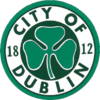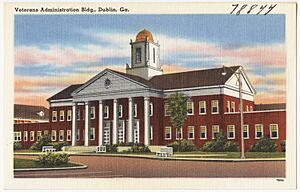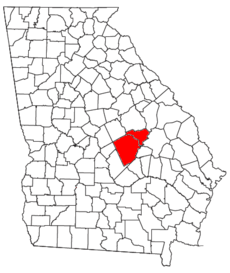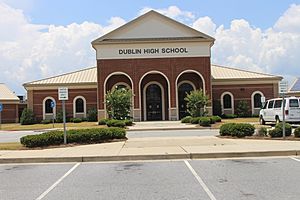Dublin, Georgia facts for kids
Quick facts for kids
Dublin, Georgia
|
|||
|---|---|---|---|
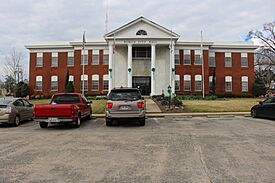
Dublin City Hall
|
|||
|
|||
| Nickname(s):
The Emerald City
|
|||

Location in Laurens County and the state of Georgia
|
|||
| Country | United States | ||
| State | Georgia | ||
| County | Laurens | ||
| Incorporated | December 9, 1812 | ||
| Area | |||
| • City | 16.401 sq mi (42.478 km2) | ||
| • Land | 16.306 sq mi (42.232 km2) | ||
| • Water | 0.095 sq mi (0.245 km2) | ||
| Elevation | 223 ft (68 m) | ||
| Population
(2020)
|
|||
| • City | 16,074 | ||
| • Estimate
(2022)
|
15,946 | ||
| • Density | 999.0/sq mi (385.7/km2) | ||
| • Urban | 20,842 | ||
| • Metro | 59,223 | ||
| Time zone | UTC−5 (Eastern (EST)) | ||
| • Summer (DST) | UTC−4 (EDT) | ||
| ZIP Codes |
31021, 31027, 31040
|
||
| Area code(s) | 478 | ||
| FIPS code | 13-24376 | ||
| GNIS feature ID | 0313692 | ||
Dublin is a city in Georgia, United States. It is the main city of Laurens County. In 2020, about 16,074 people lived there.
Contents
History of Dublin, Georgia
The city of Dublin, Georgia, was officially started on December 9, 1812. It became the main town for Laurens County. The first postmaster, Jonathan Sawyer, named the town Dublin. He chose this name because it reminded him of Dublin, the capital city of Ireland, where he was from.
A historical marker in Dublin tells us that Jefferson Davis, who was the leader of the Southern states during the American Civil War, stayed here with his family. This was just before he was captured by the Northern forces in May 1865.
Between 1880 and 1910, Dublin grew a lot. Five different railroads came through the city, and two bridges were built over the Oconee River. This made Dublin a very important place for trading cotton in central Georgia. However, in the early 1920s, tiny insects called boll weevils ruined the cotton crops. This caused big money problems for the city and many people moved away.
A very important event happened in Dublin on April 17, 1944. Martin Luther King Jr. gave his very first public speech here. It was called "The Negro and the Constitution" and he gave it at the First African Baptist Church.
Geography and Location
Dublin is in the middle of Laurens County, Georgia. Irish settlers named the town Dublin because the land, called the Middle Georgia Piedmont, looked like their home country. The city was built on the Oconee River. This river starts in the mountains and flows all the way to the Atlantic Ocean. The Oconee River forms the eastern edge of Dublin, separating it from East Dublin.
The city covers about 41.5 square kilometers (16.0 square miles) in total. Most of this area is land, with a small part being water.
How to Get to Dublin
Dublin is located along Interstate 16. You can reach the city from exits 49, 51, 54, and 58. If you travel on I-16, Savannah is about 117 miles (188 km) to the east. Macon is about 53 miles (85 km) to the northwest. Other major roads like US 80, US 319, and US 441 also pass through Dublin. US 441 connects Dublin to Milledgeville, which is 47 miles (76 km) northwest, and McRae–Helena, 35 miles (56 km) south. Many state and local roads also run through the city.
Historic Areas of Dublin
Dublin has two special historic areas that are listed on the National Register of Historic Places. This means they are important places to protect because of their history.
- The Dublin Commercial Historic District is the old downtown shopping area. It includes the oldest building, the Hicks Building, which was built in 1893. This district has 78 important buildings, like the Dublin Carnegie Library and the old Post Office. The buildings show many different styles, such as Colonial Revival, Neoclassical, and Art Deco.
- The Stubbs Park–Stonewall Street Historic District is west of the downtown area. It has 470 important properties, mostly homes built between the late 1910s and early 1940s. These homes are in styles like Craftsman, Gothic Revival, and Folk Victorian. This district also has old churches, cemeteries, and Dublin's first public park, Stubbs Park.
Weather in Dublin
| Climate data for Dublin, Georgia, 1991–2020 normals, extremes 1892–present | |||||||||||||
|---|---|---|---|---|---|---|---|---|---|---|---|---|---|
| Month | Jan | Feb | Mar | Apr | May | Jun | Jul | Aug | Sep | Oct | Nov | Dec | Year |
| Record high °F (°C) | 85 (29) |
85 (29) |
92 (33) |
99 (37) |
102 (39) |
108 (42) |
109 (43) |
109 (43) |
108 (42) |
102 (39) |
92 (33) |
88 (31) |
109 (43) |
| Mean maximum °F (°C) | 74.9 (23.8) |
78.3 (25.7) |
83.8 (28.8) |
88.7 (31.5) |
94.4 (34.7) |
97.8 (36.6) |
99.9 (37.7) |
98.7 (37.1) |
95.3 (35.2) |
89.0 (31.7) |
83.1 (28.4) |
76.9 (24.9) |
100.4 (38.0) |
| Mean daily maximum °F (°C) | 58.3 (14.6) |
62.0 (16.7) |
70.7 (21.5) |
78.3 (25.7) |
85.6 (29.8) |
90.7 (32.6) |
94.0 (34.4) |
92.2 (33.4) |
87.0 (30.6) |
77.9 (25.5) |
68.5 (20.3) |
60.6 (15.9) |
77.1 (25.1) |
| Daily mean °F (°C) | 46.7 (8.2) |
50.0 (10.0) |
57.3 (14.1) |
64.5 (18.1) |
72.5 (22.5) |
79.2 (26.2) |
82.5 (28.1) |
81.3 (27.4) |
75.7 (24.3) |
65.4 (18.6) |
55.3 (12.9) |
48.8 (9.3) |
64.9 (18.3) |
| Mean daily minimum °F (°C) | 35.1 (1.7) |
38.0 (3.3) |
44.0 (6.7) |
50.6 (10.3) |
59.4 (15.2) |
67.7 (19.8) |
71.0 (21.7) |
70.4 (21.3) |
64.4 (18.0) |
52.9 (11.6) |
42.1 (5.6) |
37.0 (2.8) |
52.7 (11.5) |
| Mean minimum °F (°C) | 20.0 (−6.7) |
23.5 (−4.7) |
27.9 (−2.3) |
36.0 (2.2) |
45.9 (7.7) |
58.2 (14.6) |
63.6 (17.6) |
62.8 (17.1) |
51.9 (11.1) |
36.8 (2.7) |
27.1 (−2.7) |
23.4 (−4.8) |
18.1 (−7.7) |
| Record low °F (°C) | 0 (−18) |
9 (−13) |
14 (−10) |
28 (−2) |
38 (3) |
40 (4) |
50 (10) |
52 (11) |
33 (1) |
25 (−4) |
11 (−12) |
5 (−15) |
0 (−18) |
| Average precipitation inches (mm) | 4.38 (111) |
4.14 (105) |
4.58 (116) |
2.75 (70) |
2.62 (67) |
5.25 (133) |
4.50 (114) |
4.81 (122) |
3.58 (91) |
3.15 (80) |
3.08 (78) |
4.43 (113) |
47.27 (1,200) |
| Average precipitation days (≥ 0.01 in) | 8.5 | 6.5 | 7.4 | 5.4 | 5.5 | 10.1 | 8.0 | 8.9 | 6.1 | 5.6 | 5.5 | 7.0 | 84.5 |
| Source 1: NOAA | |||||||||||||
| Source 2: XMACIS2/NWS | |||||||||||||
People of Dublin
| Historical population | |||
|---|---|---|---|
| Census | Pop. | %± | |
| 1880 | 574 | — | |
| 1890 | 862 | 50.2% | |
| 1900 | 2,987 | 246.5% | |
| 1910 | 5,795 | 94.0% | |
| 1920 | 7,707 | 33.0% | |
| 1930 | 6,681 | −13.3% | |
| 1940 | 7,814 | 17.0% | |
| 1950 | 10,232 | 30.9% | |
| 1960 | 13,814 | 35.0% | |
| 1970 | 15,143 | 9.6% | |
| 1980 | 16,083 | 6.2% | |
| 1990 | 16,312 | 1.4% | |
| 2000 | 15,857 | −2.8% | |
| 2010 | 16,201 | 2.2% | |
| 2020 | 16,074 | −0.8% | |
| 2022 (est.) | 15,946 | −1.6% | |
| U.S. Decennial Census 1850-1870 1870-1880 1890-1910 1920-1930 1940 1950 1960 1970 1980 1990 2000 2010 2020 Census |
|||
| Race | Number | Percent |
|---|---|---|
| Black or African American (non-Hispanic) | 9,811 | 61.04% |
| White (non-Hispanic) | 5,144 | 32.0% |
| Native American | 23 | 0.14% |
| Asian | 342 | 2.13% |
| Pacific Islander | 1 | 0.01% |
| Other/Mixed | 421 | 2.62% |
| Hispanic or Latino | 332 | 2.07% |
In 2020, there were 16,074 people living in Dublin. There were 6,459 households and 3,944 families. The city had about 1,009 people per square mile (390 per square kilometer).
Dublin's Micropolitan Area
Dublin is the main city of the Dublin micropolitan area. A micropolitan area is a smaller city area that includes a city and its nearby counties. This area includes Johnson and Laurens counties. In 2020, about 58,759 people lived in this larger area.
Arts and Culture in Dublin
Dublin has some great places for arts and entertainment.
Theatre Dublin: A Place for Shows
Theatre Dublin, first called the Martin Theater, was built in 1934. It's in Dublin's old downtown area. The theater has a cool Art Deco design, with flat walls and bright neon signs.
After being fixed up in 1996, Theatre Dublin became a center for performing arts. It hosts many different events, like concerts, plays, orchestras, and movies. It's a fun place to see a show!
Dublin Carnegie Library: History and Art
The Dublin Carnegie Library was built in 1904 with money from Andrew Carnegie. It's also in the historic downtown. This library is special because it's one of only three Carnegie Libraries in Georgia that are still in their original form and listed on the National Register of Historic Places.
It was the public library until the 1960s. Later, it became home to the Dublin-Laurens Museum for over 35 years. In 2014, the building was beautifully renovated. Now, the Dublin Carnegie Library is used for events and as an art gallery, showing art from local and statewide artists.
Education in Dublin
Dublin has several schools for students of all ages.
Public Schools
The Dublin City School District serves students inside the city. It has schools from pre-school all the way to twelfth grade. In 2016, about 2,400 students attended these schools.
- Hillcrest Elementary School
- Susie Dasher Elementary School
- Dublin Middle School
- Dublin High School
- Moore Street School (Alternative)
The Laurens County School District serves students who live outside the Dublin city limits.
Private Schools
- Trinity Christian School
Colleges and Universities
- Georgia Military College - Dublin Campus
- Oconee Fall Line Technical College - South Campus
- Middle Georgia State University - Dublin Campus
Fun Events in Dublin
Dublin is known for its exciting events.
Festivals
Dublin is famous for its annual St. Patrick's festival. It takes place every March and is a big celebration!
Sister City
Dublin has a special connection with a city in Japan:
- Osaki, Miyagi, Japan
Pageants
Dublin hosts several scholarship pageants, which are popular in the Southern United States. These competitions help students earn money for college.
- The Miss Saint Patrick's Scholarship pageant happens every March during the St. Patrick's Day celebration.
- The Dublin and Laurens County's America's Junior Miss Pageant is for high school juniors. The winners go on to compete at the state level. This competition is now called Distinguished Young Women.
Dublin in Books
Dublin, the Oconee River, and Laurens County are even mentioned in a famous book! They appear on the first page of James Joyce's book Finnegans Wake. Joyce once explained that the book mentions "Dublin, Laurens Co, Georgia, founded by a Dubliner, Peter Sawyer, on r. Oconee. Its motto: Doubling all the time."
Famous People from Dublin
Many talented people have come from Dublin, Georgia:
- Jamel Ashley, a retired track athlete
- Jermaine Hall, a basketball player
- Matt Hatchett, a businessman and politician
- Eleanor Ison Franklin (1929–1998), a medical scientist
- Anthony Kewoa Johnson, a retired mixed martial artist
- Marcos Knight, a professional basketball player
- J. Roy Rowland, a former congressman
- Imagene Stewart (1942–2012), a religious leader and activist
- Demaryius Thomas, a football player for the Denver Broncos
- Quincy Trouppe, a baseball player in the Negro leagues
- Erik Walden, a National Football League player
- Darrell Williams Jr., a football player for the San Francisco 49ers
- Leh Keen, a racing driver
See also
 In Spanish: Dublin (Georgia) para niños
In Spanish: Dublin (Georgia) para niños



